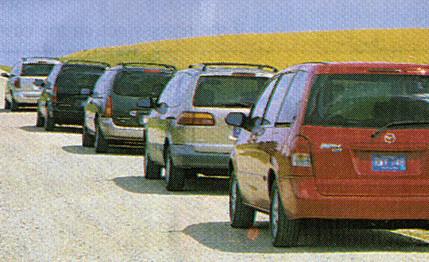
 Comparison Tests
Comparison Tests
Suburban moms no longer flaunt minivans as a fashion item -- it's SUVs that strut to the PTA meetings now -- but for every journey that stays on-road, we've always thought minis were the better choice: They have more room for people and stuff, they guzzle less fuel, and all-wheel drive is available if you really need it.
The market seems to agree. Minivan sales have stayed roughly level at 1.25 million over the past five years, with a bit of an uptick in 1999.
The news for 2001 is the all-new model from DaimlerChrysler, first mover in the category way back in 1984, and still the sales leader. Although the aging versions from Plymouth, Dodge, and Chrysler haven't won a comparison like this in the past few years, they remain the benchmarks by which all minivans are judged. The new third-generation model again raises the bar. Beyond reach of the others? That's why we do comparison tests.
The original minivan formula, you may recall, was a compact box when compared with full-size family wagons of the time, with more space inside. Who wouldn't love it? Like a lot of good ideas, the minivan was soon supersized -- stretched-wheelbase models about a foot longer overall. Now the supers have become the norm, measuring just over 200 inches bumper to bumper.
For this inquiry we're going back to the original formula: unstretched models, the standard-wheelbase jobs. It's a fuzzy category consisting of three shorts and two mediums. Unstretched minis from GM and DaimlerChrysler -- represented here by a Chevrolet Venture and a Chrysler Voyager -- are closely matched in size. The Japanese brands each come in one size only. The Mazda MPV is a shorty, with external dimensions nearly identical to the Chevy's. Think of the Toyota Sienna and the Nissan Quest (the Mercury Villager twin) as 'tweeners, sized about halfway between the standard and stretched Detroiters.
For the record, the original formula was also a front-driver. GM's Chevy Astro and GMC Safari would fit the size template here, but their rear-drive layout disqualifies them from further consideration. The popular Honda Odyssey missed the template, since it's sized to compete with the stretchers. We also excluded the rarely seen VW EuroVan. It lacks a second door on the driver's side and generally marches to a different drill sergeant.
The minivan category is fuzzy in another way. Practice restraint at the options smorgasbord, and you can drive off with a bare-bones utility runabout at a frugal price. Or let yourself go, all the way to a full-boat luxury liner with leather, rear air conditioning, various combinations of power-assisted doors, and onboard theater and game equipment to narcotize the kids. For this gathering, let's describe our focus this way: flexible transportation for up to seven occupants, priced toward the low end of the range. As a practical matter, to meet deadlines, we accepted for testing some models with high-level equipment. For example, several of the test samples had power-operated sliding doors. But since all but the Mazda could be so equipped if that were our focus, we chose not to comment on that feature. Same for back-seat theater.
Although the cast members assembled here compete against one another for your new-car dollar, each represents a different time in the minivan's evolution. The Chrysler is the latest thinking, still not in showrooms as we write this. The Mazda MPV was all-new for 2000. The Nissan Quest was substantially redesigned for 1999. The Toyota Sienna appeared in late 1997, replacing the playfully ellipsoid Previa, and the Chevy Venture was all-new for 1997. Without tipping off the final rankings, let's just say that the minivan market has no golden oldies.
Hang on as we zoom in for a closer look.